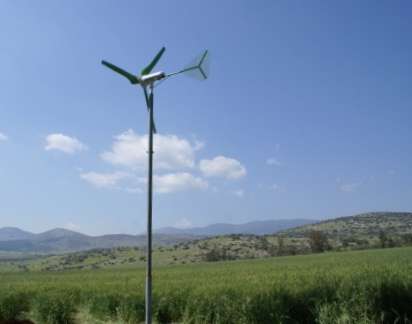New blades and generators for more efficient small wind turbines

Small wind turbines, for domestic and small scale commercial use, are currently relatively expensive and struggle to compete with solar solutions. The key to increasing their competitiveness is bringing down their cost and improving performance.
When people think about small scale renewable energy systems, for their home for example, they often think of solar panels, but there are other options. One is small wind turbines. But at the moment these struggle to be a cost-effective alternative to solar. They need to reduce in price and become more efficient at converting wind energy to electricity.
More than 940,000 small wind turbines were in use around the world by the end of 2014. Based on current rates of growth, estimates suggest that could grow by 20% by 2020. In the EU, the European Commission wants 20% of electricity to come from wind energy by the end of 2020. Improving small wind turbine cost-effectiveness could help meet this target.
The blades can have a significant impact on the performance of a small wind turbine. A Spanish engineering consultancy has been working on a design for a new set of blades to maximise wind energy conversion, as part of the European SWIP project. "The project aims to lower costs and increase the power generated by the small and medium wind turbines," says Fernando Aznar, at Solute.
One of the key elements of the design is that the tips of the new blades are wider than on other small wind turbines. The blade tips are key to improving aerodynamic performance, reducing noise and vibrations, and creating the movement that turns the blades, explains Aznar.
To optimise performance the blades have been designed in tandem with a new pitch control system. This adjusts the blades so that they sit at the best angle to the wind, to maximise efficiency. "This system has to be pushed by the blades," explains Aznar, "The passive pitch system was created and configured in order to decrease the total cost of the wind turbine and protect the machine."
Airflow around the new blades was studied using sophisticated computer modelling techniques. This allowed the researchers to estimate power production, as well as pitch torque and thrust, to aid the design of the pitch control system.
"Air flow near to the tip of the blades has a significant impact on the efficiency and the noise from the wind turbine as well as the aerodynamic force on the blade," explains Lin Ma, a mechanical engineer at the University of Sheffield in the UK, who carried out the computer modelling. "The new blade design takes consideration of the performance, noise, aesthetic aspect, the cost of manufacturing of the turbine and the long term operational and maintenance costs."

Small wind turbines are often installed in urban and semi-urban areas. But these locations are challenging as they require turbines that work at variable, often low, wind speeds while running smoothly and producing little noise. These conditions directly affect the technical requirements for wind turbine generators, explains Jorge Herrero Ciudad, a project manager at Spanish renewable energy company 4fores.
As part of the SWIP project, 4fores has developed lighter weight generators for small wind turbines in urban environments. "The challenge was to obtain a permanent magnet synchronous generator which operates at lower rotational speeds than currently used generators, while maintaining benchmark size, power and efficiency, and keeping cost at a low level," says Ciudad.
When being turned at low speeds, generators often suffer from jerkiness. This undesirable characteristic is caused by an issue known as cogging torque.
By focusing on reducing cogging torque, the researchers on the SWIP project have managed to produce a generator that vibrates less – reducing noise and improving reliability – and can start producing energy at lower wind speeds.
When combined with new power conversion electronics developed by the project, it is estimated that this will improve energy harvesting by up to 20% at the most common wind conditions in urban environments.
The new generators are also 50% lighter than conventional generators. "This has been achieved using cutting edge design methods and cutting edge materials," says Ciudad. "For instance, the structure of the generator uses aerospace-grade aluminium when typically steel is used."
A lower weight generator reduces turbine costs in two ways. The generators are cheaper as they use less material and the other parts of the turbine, such as the tower, can be smaller as they have less weight to support.
Turbines featuring the new blades and generators are being tested at three different sites, representing three different usage scenarios: energy efficient buildings, shore-lines and industrial areas.
More information: The main objective of the SWIP project is to develop and validate innovative solutions for small and medium size wind turbines to improve their competitiveness, enabling and facilitating the integration and deployment into urban and peri-urban areas.
Provided by Youris.com


















